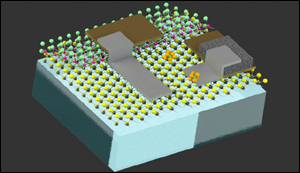Cell-sized robots can sense their environment
26. 7. 2018 | MIT | web.mit.edu
Researchers at MIT have created what may be the smallest robots yet that can sense their environment, store data, and even carry out computational tasks. These devices, which are about the size of a human egg cell, consist of tiny electronic circuits made of two-dimensional materials, piggybacking on minuscule particles called colloids.
Colloids are so small they can stay suspended indefinitely in a liquid or even in air. By coupling these tiny objects to complex circuitry, the researchers hope to lay the groundwork for devices that could be dispersed to carry out diagnostic journeys through anything from the human digestive system to oil and gas pipelines, or perhaps to waft through air to measure compounds inside a chemical processor or refinery.

Tiny robots made by the MIT team are self-powered, requiring no external power source or even internal batteries. A simple photodiode provides the trickle of electricity that the tiny robots’ circuits require to power their computation and memory circuits. That’s enough to let them sense information about their environment, store those data in their memory, and then later have the data read out after accomplishing their mission.
Read more at MIT
Image Credit: MIT
-jk-




